 Household borrowing on credit cards and through overdrafts and loans has been growing rapidly. This ‘unsecured’ borrowing is now rising at rates not seen since well before the credit crunch of 2008 (click here for a PowerPoint of the chart below). Should this be a cause for concern?
Household borrowing on credit cards and through overdrafts and loans has been growing rapidly. This ‘unsecured’ borrowing is now rising at rates not seen since well before the credit crunch of 2008 (click here for a PowerPoint of the chart below). Should this be a cause for concern?
Household confidence is generally high and, as a result, people continue to take out more loans and so household debt continues to increase. Saving rates are falling and, at 5.1% of household disposable income, are the lowest rate since 2008, mirroring the high levels of spending and borrowing.
But as long as the economy keeps growing and as long as interest rates stay at record low levels, people should be able to continue servicing this rising debt. Indeed, with generous balance transfer offers between credit cards and many people paying off their full balance each month, only 56.6% are paying any interest at all on credit card debt, the lowest level on record.
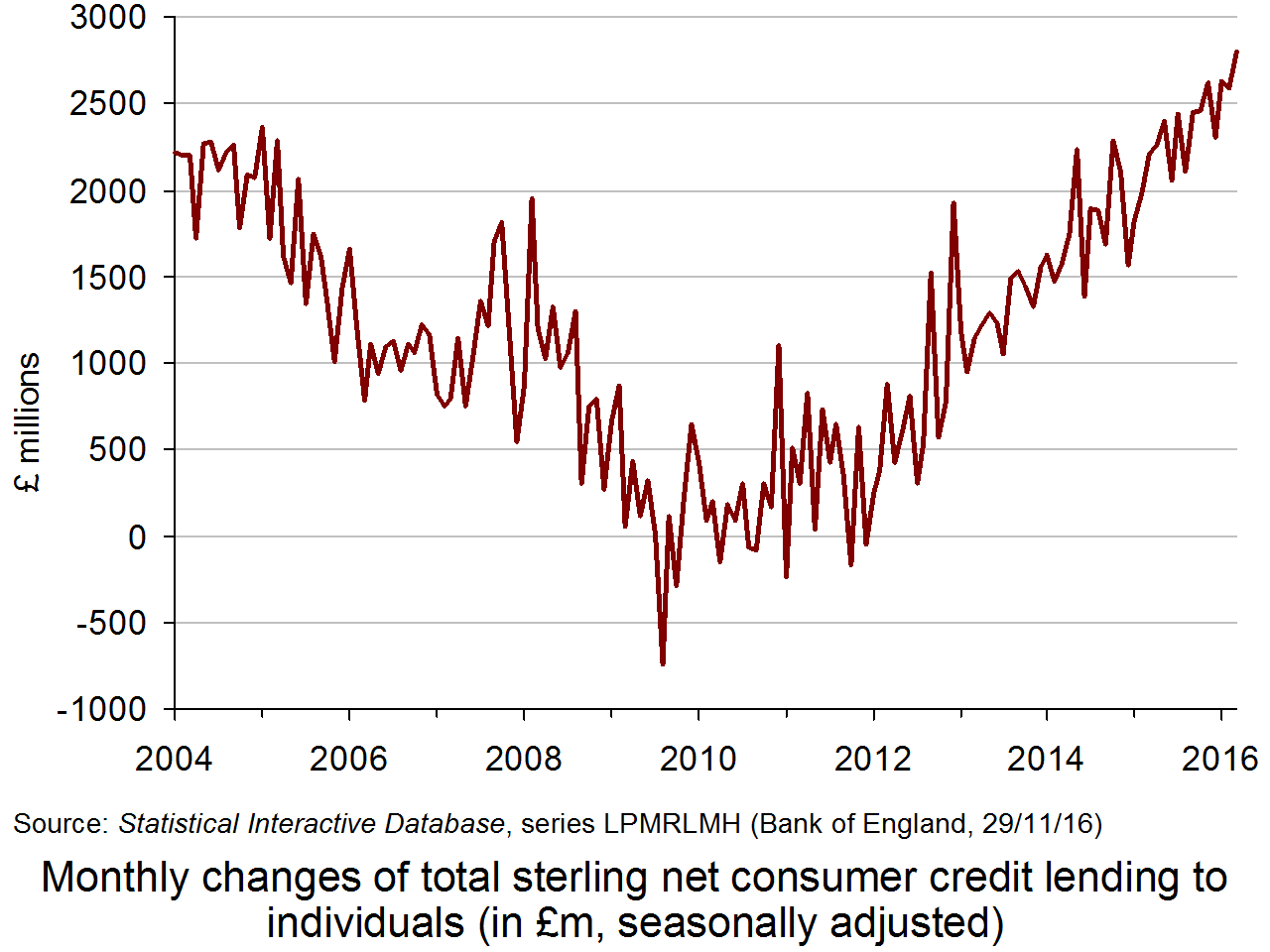 But there could be trouble ahead! Secured borrowing (i.e. on mortgages) is at record highs as house prices have soared, limiting the amount people have to left to spend, even with ultra low interest rates. Student debt is growing, putting a brake on graduate spending.
But there could be trouble ahead! Secured borrowing (i.e. on mortgages) is at record highs as house prices have soared, limiting the amount people have to left to spend, even with ultra low interest rates. Student debt is growing, putting a brake on graduate spending.
With economic growth set to slow and inflation set to rise as the effects of the lower pound filter through into retail prices, this could initially boost borrowing further as people seek to maintain levels of consumption. But then, if unemployment starts to rise and consumer confidence starts to fall, real spending could decline, putting further downward pressure on the economy.
Confidence could then fall further and we could witness a repeat of 2008–9, when people became worried about their levels of borrowing and cut back on consumption in an attempt to claw down their debt. The economy was pushed into recession.
The Bank of England is well aware of this scenario and wants banks to ensure that their customers can afford loans before offering them.
Articles
Bank governor Mark Carney warns on household debt BBC News, Brian Milligan (30/11/16)
Credit crunch: Household debt is rising just as the economy’s future is uncertain The Telegraph, Tim Wallace (10/12/16)
Bank of England publication
Financial Stability Report, November 2016 Bank of England (30/11/16)
Data
Money and lending Bank of England Interactive Database
United Kingdom Households Debt To GDP Trading Economics
Household debt OECD Data
Questions
- What determines the amount people borrow?
- What would cause people to cut back on the amount of debt they have?
- Distinguish between secured and unsecured borrowing and debt.
- Why has secured borrowing risen? Does this matter?
- What is meant by the term ‘re-leveraging’? What is its significance in terms of household borrowing?
- Find out what the affordability tests are for anyone wanting to take out a mortgage.
- What are the greatest risks to UK financial stability?
 ‘The world is sinking under a sea of debt, private as well as public, and it is increasingly hard to see how this might end, except in some form of mass default.’ So claims the article below by Jeremy Warner. But just how much has debt grown, both public and private? And is it of concern?
‘The world is sinking under a sea of debt, private as well as public, and it is increasingly hard to see how this might end, except in some form of mass default.’ So claims the article below by Jeremy Warner. But just how much has debt grown, both public and private? And is it of concern?
The doomsday scenario is that we are heading for another financial crisis as over leveraged banks and governments could not cope with a collapse in confidence. Bank and bond interest rates would soar and debts would be hard to finance. The world could head back into recession as credit became harder and more expensive to obtain. Perhaps, in such a scenario, there would be mass default, by banks and governments alike. This could result in a plunge back into recession.
The more optimistic scenario is that private-sector debt is under control and in many countries is falling (see, for example, chart 1 in the blog Looking once again through Minsky eyes at UK credit numbers for the case of the UK). Even though private-sector debt could rise again as the world economy grows, it would be affordable provided that interest rates remain low and banks continue to build the requisite capital buffers under the Basel III banking regulations.
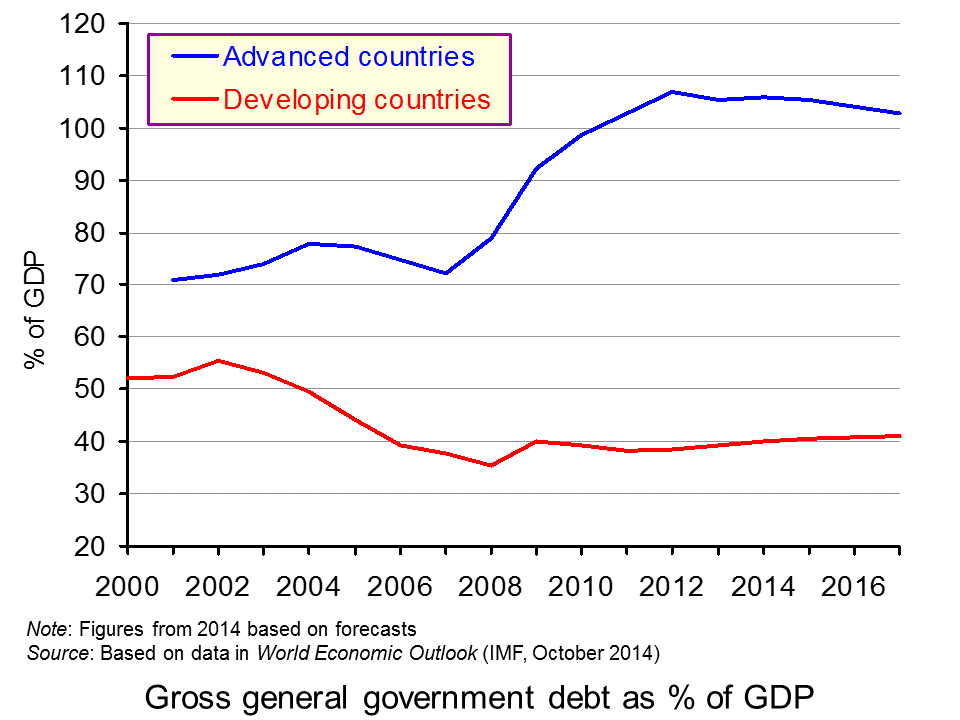 As far as public-sector debt is concerned, as a percentage of GDP its growth has begun to decline in advanced countries as a whole and, although gently rising in developing and emerging economies as a whole, is relatively low compared with advanced countries (see chart). Of course, there are some countries that still face much larger debts, but in most cases they are manageable and governments have plans to curb them, or at least their growth.
As far as public-sector debt is concerned, as a percentage of GDP its growth has begun to decline in advanced countries as a whole and, although gently rising in developing and emerging economies as a whole, is relatively low compared with advanced countries (see chart). Of course, there are some countries that still face much larger debts, but in most cases they are manageable and governments have plans to curb them, or at least their growth.
But there have been several warnings from various economists and institutes, as we saw in the blog post, Has the problem of excess global debt been tackled? Not according to latest figures. The question is whether countries can grow their way out of the problem, with a rapidly rising denominator in the debt/GDP ratios.
Only mass default will end the world’s addiction to debt The Telegraph, Jeremy Warner (3/3/15)
Questions
- What would be the impact of several countries defaulting on debt?
- What factors determine the likelihood of sovereign defaults?
- What factors determine the likelihood of bank defaults?
- What is meant by ‘leverage’ in the context of (a) banks; (b) nations?
- What are the Basel III regulations? What impact will they have/are they having on bank leverage?
- Expand on the arguments supporting the doomsday scenario above.
- Expand on the arguments supporting the optimistic scenario above.
- What is the relationship between economic growth and debt?
- Explain how the explosion in global credit might merely be ‘the mirror image of rising output, asset prices and wealth’.
- Is domestic inflation a good answer for a country to the problems of rising debt denominated (a) in the domestic currency; (b) in foreign currencies?
 According to a report by the McKinsey Global Institute, global debt is now higher than before the financial crisis. And that crisis was largely caused by excessive lending. As The Telegraph article linked below states:
According to a report by the McKinsey Global Institute, global debt is now higher than before the financial crisis. And that crisis was largely caused by excessive lending. As The Telegraph article linked below states:
The figures are as remarkable as they are terrifying. Global debt – defined as the liabilities of governments, firms and households – has jumped by $57 trillion, or 17% of global GDP, since the fourth quarter of 2007, which was supposed to be the peak of the bad old credit-fuelled days. In 2000, total debt was worth 246% of global GDP; by 2007, this had risen to 269% of GDP and today we are at 286% of GDP.
This is not how policy since the financial crisis was supposed to have worked out. Central banks and governments have been trying to encourage greater saving and reduced credit as a percentage of  GDP, a greater capital base for banks, and reduced government deficits as a means of reducing government debt. But of 47 large economies in the McKinsey study, only five have succeeded in reducing their debt/GDP ratios since 2007 and in many the ratio has got a lot higher. China, for example, has seen its debt to GDP ratio almost double – from 158% to 282%, although its government debt remains low relative to other major economies.
GDP, a greater capital base for banks, and reduced government deficits as a means of reducing government debt. But of 47 large economies in the McKinsey study, only five have succeeded in reducing their debt/GDP ratios since 2007 and in many the ratio has got a lot higher. China, for example, has seen its debt to GDP ratio almost double – from 158% to 282%, although its government debt remains low relative to other major economies.
Part of the problem is that the lack of growth in many countries has made it hard for countries to reduce their public-sector deficits to levels that will allow the public-sector debt/GDP ratio to fall.
In terms of the UK, private-sector debt has been falling as a percentage of GDP. But this has been more than offset by a rise in the public-sector debt/GDP ratio. As Robert Peston says:
[UK indebtedness] increased by 30 percentage points, to 252% of GDP (excluding financial sector or City debts) – as government debts have jumped by 50 percentage points of GDP, while corporate and household debts have decreased by 12 and 8 percentage points of GDP respectively.
So what are the likely consequences of this growth in debt and what can be done about it? The articles and report consider these questions.
Articles
Instead of paying down its debts, the world’s gone on another credit binge The Telegraph, Allister Heath (5/2/15)
Global debts rise $57tn since crash BBC News, Robert Peston (5/2/15)
China’s Total Debt Load Equals 282% of GDP, Raising Economic Risks The Wall Street Journal, Pedro Nicolaci da Costa (4/2/15)
Report
Debt and (not much) deleveraging McKinsey Global Institute, Richard Dobbs, Susan Lund, Jonathan Woetzel, and Mina Mutafchieva (February 2015)
Questions
- Explain what is meant by ‘leverage’.
- Why does a low-leverage economy do better in a downturn than a high-leverage one?
- What is the relationship between deficits and the debt/GDP ratio?
- When might an increase in debt be good for an economy?
- Comment on the statement in The Telegraph article that ‘In theory, debt is fine if it is backed up by high-quality collateral’.
- Why does the rise is debt matter for the global economy?
- Is it possible for (a) individual countries; (b) all countries collectively to ‘live beyond their means’ by consuming more than they are producing through borrowing?
- What is the structure of China’s debt and what problems does this pose for the Chinese economy?
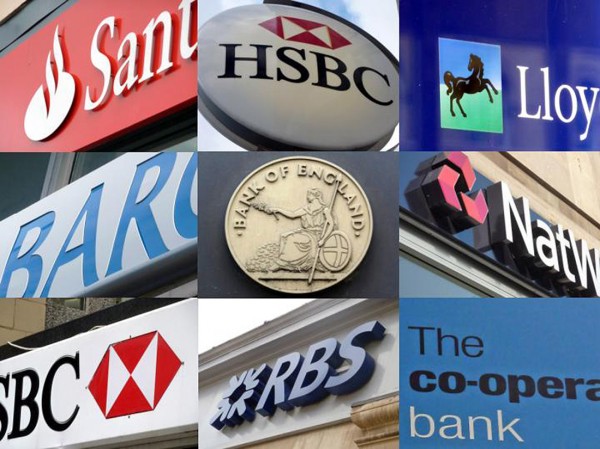 On 15 September 2008, Lehman Brothers, the fourth-largest investment bank in the USA, filed for bankruptcy. Although the credit crisis had been building since mid 2007, the demise of Lehmans was a pivotal event in the unfolding of the financial crisis and the subsequent severe recession in most developed economies. Banks were no longer seen as safe and huge amounts of government money had to be poured into banks to shore up their capital and prevent further bankruptcies. Partial nationalisation seemed the only way of rescuing several banks and with it the global financial system.
On 15 September 2008, Lehman Brothers, the fourth-largest investment bank in the USA, filed for bankruptcy. Although the credit crisis had been building since mid 2007, the demise of Lehmans was a pivotal event in the unfolding of the financial crisis and the subsequent severe recession in most developed economies. Banks were no longer seen as safe and huge amounts of government money had to be poured into banks to shore up their capital and prevent further bankruptcies. Partial nationalisation seemed the only way of rescuing several banks and with it the global financial system.
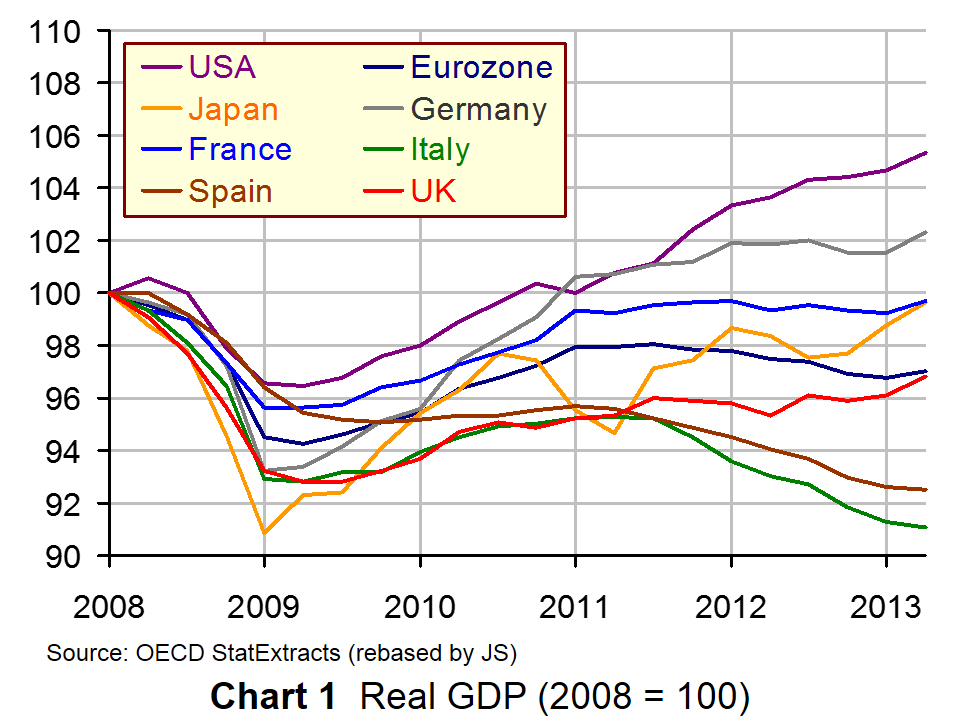 A deep and prolonged recession followed (see Chart 1: click here for a PowerPoint). In response, governments pursued expansionary fiscal policies – at least until worries about rising government deficits and debt caused a lurch to austerity policies. And central banks pursued policies of near zero interest rates and subsequently of quantitative easing. But all the time debate was taking place about how to reform banking to prevent similar crises occurring in the future.
A deep and prolonged recession followed (see Chart 1: click here for a PowerPoint). In response, governments pursued expansionary fiscal policies – at least until worries about rising government deficits and debt caused a lurch to austerity policies. And central banks pursued policies of near zero interest rates and subsequently of quantitative easing. But all the time debate was taking place about how to reform banking to prevent similar crises occurring in the future.
Solutions have included reform of the Basel banking regulations to ensure greater capital adequacy. 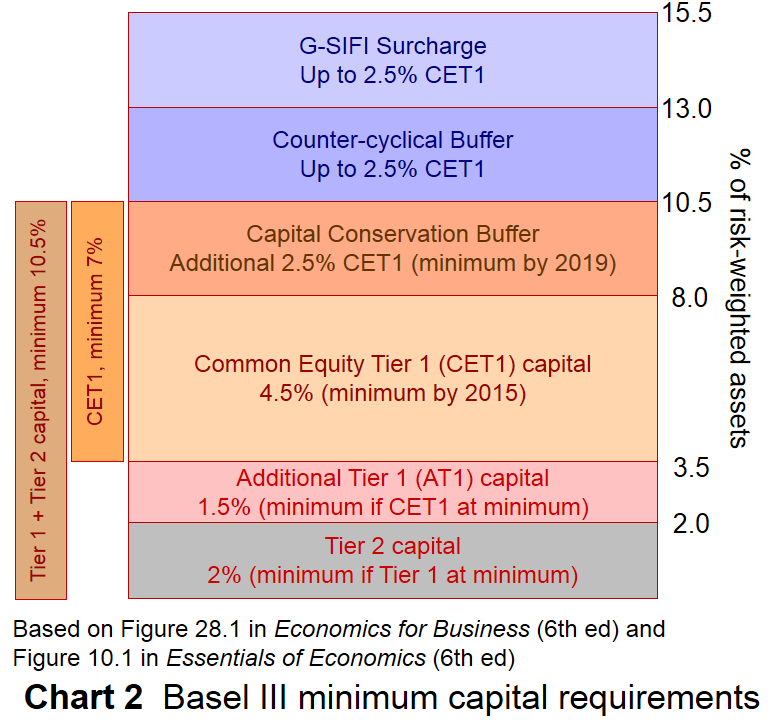 The Basel III regulations (see Chart 2) demand considerably higher capital ratios than the previous Basel II regulations.
The Basel III regulations (see Chart 2) demand considerably higher capital ratios than the previous Basel II regulations.
Other solutions have included proposals to break up banks. Indeed, just this week, the Lloyds Banking Group has hived off 631 of its branches (one sixth of the total) into a newly reformed TSB. Another proposal is to ring-fence the retail side of banks from their riskier investment divisions. In both cases the aim has been to avoid the scenario where banks are seen as too big to fail and can thus rely on governments to bail them out if they run into difficulties. Such reliance can make banks much more willing to take excessive risks. Further details of the new systems now in place are given in the Robert Peston article below.
But many critics maintain that not nearly enough has been done. Claims include:
• The Basel III rules are not tough enough and banks are still being required to hold too little capital.
• Rewards to senior bankers and traders are still excessive.
• The culture of banking, as a result, is still too risk loving in banks’ trading arms, even though they are now much more cautious about lending to firms and individuals.
• This caution has meant a continuing of the credit crunch for many small businesses.
• Higher capital adequacy ratios have reduced bank lending and have thus had a dampening effect on the real economy.
• The so-called ring-fences may not be sufficient to insulate retail banking from problems in banks’ investment divisions.
• Banks are not being required to hold sufficient liquidity to allow them to meet customers’ demands for cash in all scenarios.
• Banks’ reliance on each other still leaves a systemic risk for the banking system as a whole.
• Fading memories of the crisis are causing urgency to tackle its underlying problems to diminish.
• Problems may be brewing in less regulated parts of the banking world, such as the growing banking sector in China.
The following articles look at the lessons of the banking crisis – those that have been learned and those that have not. They look at the measures put in place and assess whether they are sufficient.
Lehman Brothers collapse, five years on: ‘We had almost no control’ The Guardian, Larry Elliott and Jill Treanor (13/9/13)
Lehman Brothers collapse: five years on, we’re still feeling the shockwaves The Guardian, Larry Elliott (13/9/13)
Five years after Lehman, could a collapse happen all over again? The Observer, Larry Elliott and Jill Treanor (15/9/13)
Five years after Lehman, all tickety-boo? BBC News, Robert Peston (9/9/13)
What have we learned from the bank crash? Independent, Yalman Onaran, Michael J Moore and Max Abelson (14/9/13)
We’ve let a good financial crisis go to waste since Lehman Brothers collapsed The Telegraph, Jeremy Warner (12/9/13)
 The Lehman legacy: Lessons learned? The Economist (9/9/13)
The Lehman legacy: Lessons learned? The Economist (9/9/13)
The dangers of debt: Lending weight The Economist (14/9/13)
The Lehman anniversary: Five years in charts The Economist (14/9/13)
Questions
- Why did Lehman Brothers collapse?
- Explain the role of the US sub-prime mortgage market in the global financial crisis of 2007/8.
- In the context of banking, what is meant by (a) capital adequacy; (b) risk-based capital adequacy ratios; (c) leverage; (d) leverage ratios?
- Explain the Basel III rules on (a) risk-based capital adequacy (see the textbook and the chart above); (b) non-risk-based leverage (introduced in 2013: see here for details).
- Explain and comment on the following statement by Adair Turner: ‘We created an over-leveraged financial system and an over-leveraged real economy. We created a system such that even if the direct cost of bank rescue was zero, the impact of their near-failure on the economy was vast.’
- Under what circumstances might the global financial system face a similar crisis to that of 2007/8 at some point in the future?
- Why is there an underlying conflict between increasing banks’ required capital adequacy and ensuring a sufficient supply of credit to consumers and business? What multiplier effects are likely to occur from an increase in the capital adequacy ratio?
 In December 2011, the ECB provided some €489bn to banks in the form of three-year loans at low interest rates (1%) through open-market operations (see Will new ECB repo operations support the eurozone bond market?).
In December 2011, the ECB provided some €489bn to banks in the form of three-year loans at low interest rates (1%) through open-market operations (see Will new ECB repo operations support the eurozone bond market?).
These ‘Longer-term refinancing operations’ or ‘LTROs’ are designed to ease the burden on European banks which have been struggling to persuade markets that they are dealing with their large amounts of toxic debt, some of which is sovereign debt. Indeed, some of the ECB loans have been used to purchase Italian and Spanish bonds, thereby reducing the likelihood that these countries will default on their debts – at least for the timebeing.
On 29 February 2012, the ECB offered another round of LTROs. Some 800 banks borrowed €530bn under the scheme, bringing the total to a little over €1tr. Initially, much of the money has been put back on overnight deposit with the ECB. The hope, however, is that the loans will be used to support increased credit throughout the eurozone and to fund further purchases of sovereign debt.
But will the increased narrow money supply in the eurozone through these open-market operations result in increased broad money and increased spending and growth? The answer to that depends a great deal on confidence: confidence of banks to lend to firms and consumers; confidence of firms and consumers to borrow. The hope is that the extra money supply will not simply see a corresponding reduction in the velocity of circulation.
The following articles consider the likely effects of these longer-term repos on the real economy.
Articles
ECB hands €529bn in emergency loans to European banks Guardian, Heather Stewart (29/2/12)
Q&A: The ECB’s bank funding programme The Telegraph, Angela Monaghan (29/2/12)
Fighting Debt with Debt Forbes, Bob McTeer (5/3/12)
Is ECB’s €1trn cash boost just the tip of the iceberg? Investment Week, Kyle Caldwell, Dan Jones (5/3/12)
Banks deposit record €821bn at ECB Financial Times, Mary Watkins (5/3/12)
Europe economy may see slim gain from supersize funding: poll Reuters, Sumanta Dey (5/3/12)
Who is the ECB helping? BBC News, Stephanie Flanders (29/2/12)
ECB information on OMOs
Open Market Operations ECB
Questions
- Explain how longer-term refinancing operations work.
- What will determine how much of these ECB loans will be lent to companies?
- Explain what is meant by (a) the velocity of circulation; (b) the money multiplier. Why will the size of these two determine the likely success of the ECB’s LTRO programme?
- Why may the ECB’s actions boost market sentiment? Why might they have the opposite effect?
- Explain what is meant by the “continued de-leveraging by banks”. How does this impact on the money multiplier?
 Household borrowing on credit cards and through overdrafts and loans has been growing rapidly. This ‘unsecured’ borrowing is now rising at rates not seen since well before the credit crunch of 2008 (click here for a PowerPoint of the chart below). Should this be a cause for concern?
Household borrowing on credit cards and through overdrafts and loans has been growing rapidly. This ‘unsecured’ borrowing is now rising at rates not seen since well before the credit crunch of 2008 (click here for a PowerPoint of the chart below). Should this be a cause for concern? But there could be trouble ahead! Secured borrowing (i.e. on mortgages) is at record highs as house prices have soared, limiting the amount people have to left to spend, even with ultra low interest rates. Student debt is growing, putting a brake on graduate spending.
But there could be trouble ahead! Secured borrowing (i.e. on mortgages) is at record highs as house prices have soared, limiting the amount people have to left to spend, even with ultra low interest rates. Student debt is growing, putting a brake on graduate spending.






